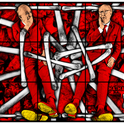In the last year, almost all of Alfred Hitchcock's films have been released on DVD. Not just the famous ones like Rear Window and Psycho, but the witty, compact British pictures and the brooding silent films too. I've said it before, but it's worth repeating: such access to film's splendid past is unprecedented. We are in an era of movie plenitude.
Now that all Hitch's films are stacked on my shelves, it has never been easier to ask what kind of artist, and how significant, he was. But how? Tens of thousands of words have been written on the sexuality of films like To Catch a Thief. French critics in particular have studied the morality of Vertigo, Strangers on a Train and The Wrong Man. And Psycho, The 39 Steps and The Birds have been hailed as aesthetically exemplary.
In the wake of decades of writing about Hitchcock, how might we see the work afresh? Well, how about this? We put Hitchcock in the ring with Pablo Picasso—often considered among the greatest of 20th-century visual artists—gumshield in place and clock ticking, to see how the Englishman stands up to the Spaniard.
At first this seems absurd. Picasso was polygeneric. He painted, sculpted, potted, drew and designed, whereas Hitchcock made only movies and television. Picasso's visual language was far more international—think of the African masks in Les Demoiselles d'Avignon or the state of the nation tableau of Guernica. Though Hitchcock worked in Britain and America, and shot documentary footage in the death camps of the second world war, he was noticably uninterested in the cinema of social concern. Round one to Picasso.

Zoom out from the specifics of women to the more general question of tone and we get another split verdict. The giganticism of people in much of Picasso's work, combined with their triple faces and sometimes Hindu-god eye positioning, is the same kind of signature as the dreamlike, velvet, gliding flow in Hitchcock, where desire creates a kind of reverie or flooding.
The bell for round four takes us into deeper, more contested territory. Consider, for example, the relationship between each artists' imagery and their subconscious. There are scenes in Hitchcock—the way the man and woman are handcuffed in The 39 Steps, the ominous arrival of Ivor Novello in The Lodger, the close-up of Hedren's handbag in Marnie, the wordless crop-dusting sequence in North by Northwest—which are inexplicably resonant and visually radioactive. They have been drawn from the deep well of Hitchcock's unconscious mind, and to see them on the "surface" is somehow shocking. Picasso's self-image as a priapic minotaur or bull, especially in the later works, seems literal or shallow in comparison. There is a sense, looking at Picasso's late works, that he is digging down from the surface, looking for deep meaning, whereas Hitchcock hauls upwards, searching for the light. Round four to Hitchcock.
The Spaniard and the Englishman were astonishing grammarians. It's arguable that no filmmaker had a more precise feel than Hitchcock for what the French call découpage—how to break a scene down into its constituent angles. Martin Scorsese once told me that if you want to know where to put your camera, you should watch Dial M for Murder, a relatively minor Hitchcock. Scorsese's point is that even when Hitchcock's "sentences" weren't showy, they were still perfectly judged. But Hitchcock's use of film language, though exemplary, was relatively classical. Cubism, which Picasso co-authored with Georges Braque, was more shocking, energetic and decentring. Nothing in Hitchcock assaults the viewer's subjectivity as much as, say, Woman in an Armchair in the National Gallery in Prague. In the boxing match of form and content, then, the Spaniard just trumps the Englishman. Three rounds to two.
But what if we measure each against a sixth, rather un-European, yardstick: emptiness or stillness; what in Buddhist aesthetics is called mu? As far as I know, neither expressed much interest in this idea, which is why it is intriguing to parachute it into the ring to see how each copes.
There's stillness in blue-period Picasso, but as the years went on, he seemed more and more mu-averse. The recipe of women, fame, war and mythology produced in him an imaginative tumult which resulted in wildly busy canvases. In Hitchcock's films, which are tight as machines to make our heads race, stillness was a structural element from the start. Marion Crane's driving at night in Psycho, the croft scene in The 39 Steps, the crop-dusting sequence in North by Northwest, Jimmy Stewart watching the people in the tenement opposite him in Rear Window: all of these moments allowed audiences to find a still centre from which to orient themselves within the story. More than entertaining us for 50 years, or dignifying movie classicism, this was the best thing that Alfred Hitchcock did. In comparison, Picasso screamed. So Hitchcock wins this point—and scrapes a draw.












